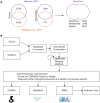Modeling Meets Metabolomics-The WormJam Consensus Model as Basis for Metabolic Studies in the Model Organism Caenorhabditis elegans
- PMID: 30488036
- PMCID: PMC6246695
- DOI: 10.3389/fmolb.2018.00096
Modeling Meets Metabolomics-The WormJam Consensus Model as Basis for Metabolic Studies in the Model Organism Caenorhabditis elegans
Abstract
Metabolism is one of the attributes of life and supplies energy and building blocks to organisms. Therefore, understanding metabolism is crucial for the understanding of complex biological phenomena. Despite having been in the focus of research for centuries, our picture of metabolism is still incomplete. Metabolomics, the systematic analysis of all small molecules in a biological system, aims to close this gap. In order to facilitate such investigations a blueprint of the metabolic network is required. Recently, several metabolic network reconstructions for the model organism Caenorhabditis elegans have been published, each having unique features. We have established the WormJam Community to merge and reconcile these (and other unpublished models) into a single consensus metabolic reconstruction. In a series of workshops and annotation seminars this model was refined with manual correction of incorrect assignments, metabolite structure and identifier curation as well as addition of new pathways. The WormJam consensus metabolic reconstruction represents a rich data source not only for in silico network-based approaches like flux balance analysis, but also for metabolomics, as it includes a database of metabolites present in C. elegans, which can be used for annotation. Here we present the process of model merging, correction and curation and give a detailed overview of the model. In the future it is intended to expand the model toward different tissues and put special emphasizes on lipid metabolism and secondary metabolism including ascaroside metabolism in accordance to their central role in C. elegans physiology.
Keywords: Caenorhabditis elegans; metabolic pathways; metabolic reconstruction; metabolism; metabolomics.
Figures




Similar articles
-
Quo Vadis Caenorhabditis elegans Metabolomics-A Review of Current Methods and Applications to Explore Metabolism in the Nematode.Metabolites. 2021 Apr 29;11(5):284. doi: 10.3390/metabo11050284. Metabolites. 2021. PMID: 33947148 Free PMC article. Review.
-
Suggestions for Standardized Identifiers for Fatty Acyl Compounds in Genome Scale Metabolic Models and Their Application to the WormJam Caenorhabditis elegans Model.Metabolites. 2020 Mar 28;10(4):130. doi: 10.3390/metabo10040130. Metabolites. 2020. PMID: 32231124 Free PMC article.
-
The Caenorhabditis elegans lipidome: A primer for lipid analysis in Caenorhabditis elegans.Arch Biochem Biophys. 2016 Jan 1;589:27-37. doi: 10.1016/j.abb.2015.06.003. Epub 2015 Jun 10. Arch Biochem Biophys. 2016. PMID: 26072113 Review.
-
Translational Metabolomics of Head Injury: Exploring Dysfunctional Cerebral Metabolism with Ex Vivo NMR Spectroscopy-Based Metabolite Quantification.In: Kobeissy FH, editor. Brain Neurotrauma: Molecular, Neuropsychological, and Rehabilitation Aspects. Boca Raton (FL): CRC Press/Taylor & Francis; 2015. Chapter 25. In: Kobeissy FH, editor. Brain Neurotrauma: Molecular, Neuropsychological, and Rehabilitation Aspects. Boca Raton (FL): CRC Press/Taylor & Francis; 2015. Chapter 25. PMID: 26269925 Free Books & Documents. Review.
-
Modeling tissue-relevant Caenorhabditis elegans metabolism at network, pathway, reaction, and metabolite levels.Mol Syst Biol. 2020 Oct;16(10):e9649. doi: 10.15252/msb.20209649. Mol Syst Biol. 2020. PMID: 33022146 Free PMC article.
Cited by
-
Quo Vadis Caenorhabditis elegans Metabolomics-A Review of Current Methods and Applications to Explore Metabolism in the Nematode.Metabolites. 2021 Apr 29;11(5):284. doi: 10.3390/metabo11050284. Metabolites. 2021. PMID: 33947148 Free PMC article. Review.
-
Leveraging open cheminformatics tools for non-targeted metabolomics analysis of C. elegans: a workflow comparison and application to strains related to xenobiotic metabolism and neurodegeneration.Anal Bioanal Chem. 2025 Aug 8. doi: 10.1007/s00216-025-06048-y. Online ahead of print. Anal Bioanal Chem. 2025. PMID: 40775120
-
Networks and Graphs Discovery in Metabolomics Data Analysis and Interpretation.Front Mol Biosci. 2022 Mar 8;9:841373. doi: 10.3389/fmolb.2022.841373. eCollection 2022. Front Mol Biosci. 2022. PMID: 35350714 Free PMC article. Review.
-
Architect: A tool for aiding the reconstruction of high-quality metabolic models through improved enzyme annotation.PLoS Comput Biol. 2022 Sep 8;18(9):e1010452. doi: 10.1371/journal.pcbi.1010452. eCollection 2022 Sep. PLoS Comput Biol. 2022. PMID: 36074804 Free PMC article.
-
Suggestions for Standardized Identifiers for Fatty Acyl Compounds in Genome Scale Metabolic Models and Their Application to the WormJam Caenorhabditis elegans Model.Metabolites. 2020 Mar 28;10(4):130. doi: 10.3390/metabo10040130. Metabolites. 2020. PMID: 32231124 Free PMC article.
References
Grants and funding
LinkOut - more resources
Full Text Sources
Miscellaneous

